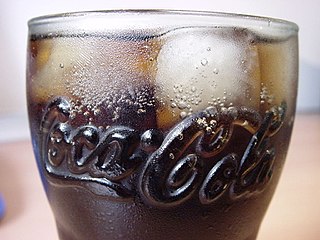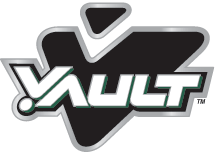
Coca-Cola, or Coke, is a carbonated soft drink manufactured by the Coca-Cola Company. In 2013, Coke products were sold in over 200 countries worldwide, with consumers drinking more than 1.8 billion company beverage servings each day. Coca-Cola ranked No. 87 in the 2018 Fortune 500 list of the largest United States corporations by total revenue. Based on Interbrand's "best global brand" study of 2020, Coca-Cola was the world's sixth most valuable brand.

Cola is a carbonated soft drink flavored with vanilla, cinnamon, citrus oils, and other flavorings. Cola became popular worldwide after the American pharmacist John Stith Pemberton invented Coca-Cola, a trademarked brand, in 1886, which was imitated by other manufacturers. Most colas originally contained caffeine from the kola nut, leading to the drink's name, though other sources have since been used. The Pemberton cola drink also contained a coca plant extract. His non-alcoholic recipe was inspired by the coca wine of pharmacist Angelo Mariani, created in 1863.

Irn-Bru is a Scottish carbonated soft drink, often described as "Scotland's other national drink". Introduced in 1901, the drink is produced in Westfield, Cumbernauld, North Lanarkshire, by A.G. Barr of Glasgow.

The Coca-Cola Company's formula for Coca-Cola syrup, which bottlers combine with carbonated water to create the company's flagship cola soft drink, is a closely guarded trade secret. Company founder Asa Candler initiated the veil of secrecy that surrounds the formula in 1891 as a publicity, marketing, and intellectual property protection strategy. While several recipes, each purporting to be the authentic formula, have been published, the company maintains that the actual formula remains a secret, known only to a very few select employees.

Inca Kola is a soft drink that was created in Peru in 1935 by British immigrant Joseph Robinson Lindley. The soda has a sweet, fruity flavor that somewhat resembles its main ingredient, lemongrass. Americans compare its flavor to bubblegum or cream soda, and it is sometimes categorized as a champagne cola.

Vault was a sweetened energy drink and carbonated beverage that was released by The Coca-Cola Company in June 2005 and marketed until December 2011. It was touted as an artificially flavored hybrid energy soda. Coca-Cola was marketing Vault as a combination with the slogan "Drinks like a soda, kicks like an energy drink," as well as "The Taste. The Quench. The Kick." "Get it done, and then some", "Chug & Charge", and "Get to it!".

Fanta Kola Inglesa is a Peruvian soft drink. It is red in color and cherry-strawberry flavor. Introduced in 1912, Kola Inglesa currently comes in several sizes including a 3-liter bottle and a 500ml bottle. The drink is popular across Peru as in some Latin American markets in the United States. The brand was first owned by Manuel A. Ventura, who created the drink for the Peruvian market. In 1971 the recipe was sold to Mr. Enrique Heredia Alarcón. It was during this time that the drink became highly popular among Peruvians. In 1997, the brand was sold to The Coca-Cola Company along with Agua San Luis. In 2013 the name changed to Fanta Kola Inglesa.

Club Cool is an attraction and gift shop located in the former Innoventions East building within Epcot at the Walt Disney World Resort in Lake Buena Vista, Florida. It features complimentary samples of Coca-Cola soft drinks from around the world, similar to the World of Coca-Cola's tasting area in Atlanta, Georgia, although the latter offers a larger selection of products to taste. Club Cool also offers Coca-Cola merchandise for purchase. The attraction reopened on September 15, 2021, along with the Creations Shop in the building that formerly housed Innoventions East and Mouse Gear, which became part of World Celebration.

Aquarius (アクエリアス) is an American-owned Japanese brand of sports drink manufactured by The Coca-Cola Company. It originated in 1978, and was first introduced in 1983 in Japan as a grapefruit-flavored sports drink, as a response to a competitor's brand of sports drink called Pocari Sweat. It was introduced in Spain and Portugal in 1991, and was the official drink of the 1992 Summer Olympics in Barcelona, 1994 Winter Olympics in Norway, 2008 Summer Olympics in Beijing, 2016 Summer Olympics in Rio de Janeiro, and the 2020 Summer Olympics. The brand has been heavily marketed by giving away free samples in sporting events.

Ajegroup, commonly known as AJE, is a Peruvian multinational company dedicated to the manufacture, distribution and sale of alcoholic and non-alcoholic beverages. The company was founded by the Añaños-Jerí Family in 1988 in Ayacucho, Peru. It is known for its flagship products Kola Real and Big Cola.

Perú Cola is a Peruvian range of soft drinks. Perú Cola is a brand of the Embotelladora Don Jorge S.A.C. company, a former bottler of Coca-Cola and later Inca Kola products. Perú Cola was introduced in Peru in 2002 after the take-over of Inca Kola by the Coca-Cola Company. Perú Cola is sold in glass bottles of 500 ml and PET bottles of 500 ml, 1.5 liter, 2.2 liter and 3.3 liter.
Isaac Kola is a Peruvian soft drink. It is brand of the Embotelladora Don Jorge S.A.C. company, a former bottler of Coca-Cola and later Inca Kola products.

Viva is a Peruvian brand of soft drink owned by Backus and Johnston and sold in Perú. Viva is a rival product to Inca Kola sharing the same characteristics such as the yellow color. Viva is sold in PET bottles of 500 mL.

Kola Escocesa which translates to "Scottish cola" is a Peruvian soft drink. It is a brand of the Yura company, located in town of Yura, not far from the city of Arequipa. The beverage has been produced since the 1950s, using mineral water from the company's own water source. It is sold in PET bottles of 440ml, 600 ml, and 1.5 litres. Bottles come in both plastic and glass. Plastic is available in all sizes and the bottles take the former of a clear plastic bottle with a red label. Glass bottles are a clear glass with writing directly on the bottle in a white color. Glass bottles are available in 600ml and 1.5L sizes. The soda can be hard to find outside of the city of Arequipa. The soda is also available in a light variant which has no sugar. Plastic bottles that are available in the light variant fade to white near the bottom of the red label. These bottles also have the word light on the label instead of clasica.

Arca Continental Lindley S.A. is a 100-year-old Peruvian company, listed on the Lima Stock Exchange as CORLINI1, involved in the manufacturing, distribution and marketing of nonalcoholic beverages and the official bottler and distributor of all Coca-Cola products in Peru. The Lindley Corporation is best known for its creation and marketing of Inca Kola, the number one selling soft drink in Peru. The Lindley Corporation, located in the historic District of Lima, Peru, is also a major promoter of plastic recycling programs in Peru. Its president is Johnny Lindley Suarez.














